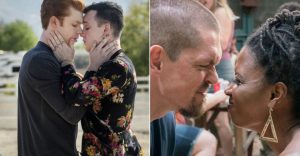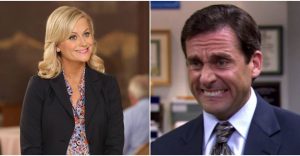Red Riding Hood: Ending & The Wolf’s Identity Explained

Adapted from the classic French folktale, Red Riding Hood adds elements of teen drama to the fantasy horror movie with a twist ending regarding the Big Bad Wolf’s identity.
Directed by Catherine Hardwicke and released in 2011, Red Riding Hood stars Amanda Seyfried, Shiloh Fernandez, and Max Irons—the three young adults are living in a village called Daggerhorn and involved in a love triangle when their home is threatened by the presence of a man-eating wolf. Adapting the legend of Little Red Riding Hood—known as “Little Red Cap” in the Brothers Grimm version—there are elements of classic werewolf tales coupled with the elements from the folktale such as the young woman named Valerie (Seyfried), who is gifted a red coat from her grandmother, and the wolf’s looming, ever-present danger after Red Riding Hood is so unfortunate to catch his eye.
The movie changes a lot from the original story, and focuses more on the larger question of who—amongst the villagers—could be the murderer. The folktale focuses more on Little Red Riding Hood and her grandmother, to whom she has been visiting with food to aid her when she is frail and sickly. Red Riding Hood adapts traditional elements of teen supernatural dramas like The Vampire Diaries and Twilight by creating a love triangle between a young woman and the two young men who are vying for her love and attention. Red Riding Hood also plays out a traditional-styled “whodunit” mystery that ramps up the fear and paranoia of the villagers, aided by the appearance of a witch hunter, Father Solomon (Gary Oldman) who comes to slay the beast.
Red Riding Hood: The Big Bad Wolf’s Identity Explained

The end of Red Riding Hood revealed Valerie’s father, Cesaire (Billy Burke) to be the wolf. Not only was this a shocking turn of events because it meant that Cesaire killed Valerie’s sister, Lucie and was responsible for all the other murders that have taken place at Daggerhorn. While it was revealed early in the movie that Lucie was actually not Cesaire’s daughter, it added motive to Cesaire being the wolf, though this was never made obvious. Rather, Red Riding Hood cleverly focused on Cesaire’s drinking problem, as if it was caused by his extreme grief over losing his young daughter rather than him drinking to control his violent impulses.
Valerie can hear the wolf speaking—this is what originally clued Cesaire in that Lucie wasn’t his daughter, and why he killed her. In their final confrontation, he explains to Valerie that he meant to choose the eldest to join him so he could eventually take both of his children and leave to have a family of their own. However, when Lucie couldn’t communicate with him, he knew she wasn’t his biological daughter. This is also why he killed Adrien, Henry’s father—he was Lucie’s real father from his affair with Cesaire’s wife, Valerie’s mother, Suzette (Virginia Madsen). Cesaire also slashed Suzette’s face in one encounter and murdered Grandmother (Julie Christie). The werewolf’s identity was teased and led audiences to believe many could be the wolf: the main suspects were set up to be Grandmother, Henry (Max Irons), and Peter (Shiloh Fernandez).
What Happened To Valerie & Peter?

Valerie and Peter manage to slay the wolf; Valerie kills her father with Father Solomon’s severed hand, which has silver fingernails. However, Peter ends up being wounded in the battle, bitten by the wolf. Father Solomon warned all the villagers of Daggerhorn that during the blood moon, anyone bitten by the wolf would be cursed to be a wolf as well. This was part of Cesaire’s plan—he wished to transfer his gift to his daughters, just as his father had passed it to him. Though Valerie was torn between her betrothed, Henry, and Peter, whom she’d loved since childhood, the decision was made around the halfway point, when she returned the bracelet Henry gave her to him.
Valerie and Peter’s relationship became doomed when Peter was bitten by Cesaire; he would turn into a wolf, and there was no escaping it. While it meant that their relationship couldn’t continue in the way they might have wanted, Valerie moved into her grandmother’s house and waited for him. The ending of the movie shows that Peter has returned. What this could mean is that he’s come back to bring her with him on the next blood moon so they can be together. Before they parted, Peter made a promise to Valerie that he would learn how to control his gift; he wasn’t a genetic wolf like she is or like her father was, so it likely would take some time for him to be able to ensure her safety with the intensity of his new instincts. Since Valerie can communicate with werewolves, they will always be able to have some larger contact, even if they don’t continue a relationship.
What The Wolf & Red Riding Hood’s Ending Really Means

Traditionally, werewolf mythology speaks to the animal nature present in humanity. It signifies a loss of control, or even a loss of innocence. Other times, such as in movies like Ginger Snaps, it can mean a coming of age or coming into one’s sexuality, when a young person is turned into a werewolf and has to undergo a significant transformation. In Red Riding Hood, the wolf seems to represent true evil and the mistrust present in mankind. As the villagers of Daggerhorn are first content to ignore Father Solomon’s warnings about the wolf being present amongst them, they eventually come face to face with the beast and then start to get paranoid. Suddenly, everyone is a suspect.
When Valerie is revealed to be able to hear the wolf, she is also accused of witchcraft, which leads to her being masked and humiliated in the town square, then set out as bait for the wolf. This represents the time period—which is never explicitly stated, but could likely be in the 1600s and 1700s, at the time when men were often suspicious of women for everything from witchcraft to adultery without any sort of concrete proof. The backdrop of the wolf being assumed to be Grandmother by Valerie and Valerie presumed to be evil because of her ability to hear the wolf and her red coat is representative of the time.
Also, Valerie is sexually active with Peter before they are wed and while she’s being considered for marriage by another, which points to more traditional themes held in werewolf movies, where sexuality being present is indicative of a wolf or some other evil. Though Red Riding Hood deviates from both the original story and classic werewolf elements, they are still present in the underlying themes of the movie.
About The Author


















